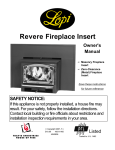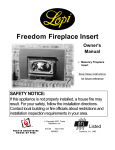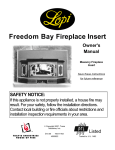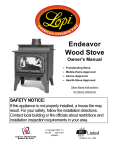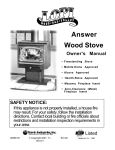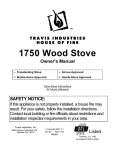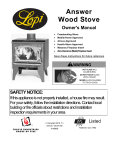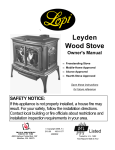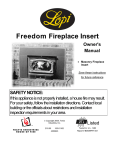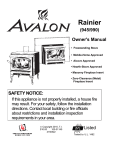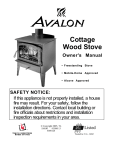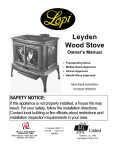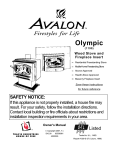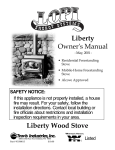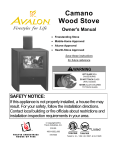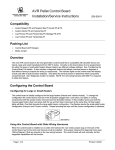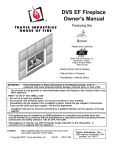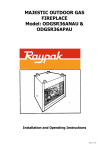Download Lopi Liberty Wood Stove Stove User Manual
Transcript
Liberty Wood Stove Owner's Manual • Freestanding Stove • Mobile-Home Approved • Alcove Approved • Hearth-Stove Approved Save these instructions for future reference SAFETY NOTICE: If this appliance is not properly installed, a house fire may result. For your safety, follow the installation directions. Contact local building or fire officials about restrictions and installation inspection requirements in your area. Copyright 2007, T.I. $10.00 100-01164 4050922 Listed Tested to: U.L. 1482 2 Introduction Introduction We welcome you as a new owner of a Lopi Liberty wood-burning stove. In purchasing a Lopi Liberty you have joined the growing ranks of concerned individuals whose selection of an energy system reflects both a concern for the environment and aesthetics. The Lopi Liberty is one of the finest appliances the world over. This manual will explain the installation, operation, and maintenance of this appliance. Please familiarize yourself with the Owner's Manual before operating your appliance and save the manual for future reference. Included are helpful hints and suggestions which will make the installation and operation of your new appliance an easier and more enjoyable experience. We offer our continual support and guidance to help you achieve the maximum benefit and enjoyment from your appliance. Important Information No other Lopi Liberty appliance has the same serial number as yours. The serial number is stamped onto the label on the back of the appliance. This serial number will be needed in case you require service of any type. Model: Serial Number: Mail your Warranty Card Today, and Save Your Bill of Sale. To receive full warranty coverage, you will need to show evidence of the date you purchased your appliance. Do not mail your Bill of Sale to us. Lopi Liberty We suggest that you attach your Bill of Sale to this page so that you will have all the information you need in one place should the need for service or information occur. Purchase Date: Purchased From: © Travis Industries 100-01164 4041115 Table of Contents 3 Maintaining Your Appliance General Information Introduction & Important Information...................... 2 Daily Maintenance ............................................. 24 Safety Precautions ............................................ 4 Remove Ash .................................................... 24 Features & Specifications.................................... 6 Clean The Glass ............................................... 24 Monthly Maintenance ......................................... 25 Stove Installation Door and Glass Inspection .................................. 26 Planning The Installation..................................... 7 Check For Creosote Buildup ................................ 25 Floor Protection Requirements ............................. 8 Yearly Maintenance ........................................... 26 Stove Placement Requirements ........................... 8 Touch Up Paint ................................................. 26 Clearances ...................................................... 8 Blower Cleaning................................................ 26 Chimney Requirements ...................................... 10 Firebrick and Baffle Inspection ............................. 26 Chimney Termination Requirements...................... 11 Door Parts ....................................................... 27 Outside Air Requirements ................................... 11 Replacing the Glass........................................... 27 Alcove Installation Requirements .......................... 12 Replacing the Door Gasket.................................. 27 Mobile Home Requirements ................................ 13 Replacing the Door Handle.................................. 27 INSTALLATION DIAGRAMS Firebox Parts.................................................... 28 Standard Ceiling with a Factory Built Chimney......... 14 Floor & Side Firebrick Removal & Replacement....... 28 Cathedral Ceiling with a Factory Built Chimney........ 14 Baffle Removal and Replacement ......................... 29 Exterior Factory Built Chimney ............................. 15 Air Tube Removal and Replacement ..................... 29 Hearth Stove Positive Connection......................... 15 Hearth Stove Direct Connection ........................... 16 Warranty Warranty ......................................................... To Interior Masonry Chimney ................................... 16 Operating Your Appliance Listing Information Safety Notice.................................................... 17 Before Your First Fire ......................................... 17 Listing Information ............................................. 31 Optional Equipment Opening the Door .............................................. 17 Door Shell Installation ........................................ 32 Bypass Operation.............................................. 18 Stove Legs....................................................... 34 Starting a Fire................................................... 19 Pedestal .......................................................... 35 Adjusting the Burn Rate ...................................... 20 Rear Blower Installation ...................................... 36 Ash Removal.................................................... 20 Outside Air Boot Installation................................. 37 Optional Blower Operation .................................. 21 Re-Loading the Stove......................................... 21 Index Overnight Burn ................................................. 21 Index .............................................................. 38 Normal Operating Sounds ................................... 21 Hints for Burning ............................................... 22 Selecting Wood................................................. 22 Troubleshooting ................................................ 23 © Travis Industries 100-01164 4041115 4 Safety Precautions The viewing door must be closed and latched during operation. Gas Never block free airflow through the air vents on this appliance. This appliance is designed and approved for the burning of cord wood only. Do not attempt to burn any other type of fuel other than cord wood in this appliance, it will void all warranties and safety listings. Do not touch the appliance while it is hot and educate all children of the danger of a hightemperature appliance. Young children should be supervised when they are in the same room as the appliance. ASHES Inspect the chimney connector and chimney at least twice monthly and clean if necessary. Creosote may build up and cause a house fire. Do not connect this appliance to any chimney serving another appliance. © Travis Industries 100-01164 Ok Type HT Ashes must be disposed in a metal container with a tight lid and placed on a noncombustible surface well away from the home or structure. Keep furniture, drapes, curtains, wood, paper, and other combustibles a minimum of 36" away from the front of the appliance. 36" This appliance must be properly installed to prevent the possibility of a house fire. The instructions must be strictly adhered to. Do not use makeshift methods or compromise in the installation. Gasoline or other flammable liquids must never be used to start the fire or "Freshen Up" the fire. Do not store or use gasoline or other flammable liquids in the vicinity of this appliance. Clay Liner Contact your local building officials to obtain a permit and information on any installation restrictions or inspection requirements in your area. Notify your insurance company of this appliance as well. This appliance must be connected to a listed high temperature (UL 103 HT) residential type chimney or an approved masonry chimney with a standard clay tile, or stainless steel liner. 4041115 Safety Precautions Mobile Home When installed in a mobile home, this appliance must be bolted to the floor, have outside air, and not be installed in the bedroom (Per H.U.D. requirements). Check with local building officials. Never try to repair or replace any part of this appliance unless instructions are given in this manual. All other work must be done by a trained technician. A A A A 5 Do not place clothing or other flammable items on or near this appliance. Do not make any changes or modifications to an existing masonry fireplace or chimney to install this appliance. Do not make any changes to the appliance to increase combustion air. Allow the appliance to cool before carrying out any maintenance or cleaning. Maintain the door and glass seal and keep them in good condition. Overfiring the appliance may cause a house fire. If a unit or chimney connector glows, you are overfiring. Do not use a grate or other device to elevate the fire off of the firebox floor. Burn the fire directly on the bricks. Avoid placing wood against the glass when loading. Do not slam the door or strike the glass. This Manual © Travis Industries Do not throw this manual away. This manual has important operating and maintenance instructions that you will need at a later time. Always follow the instructions in this manual. 100-01164 Travis Industries, Inc. grants no warranty, implied or stated, for the installation or maintenance of your appliance, and assumes no responsibility of any consequential damage(s). 4041115 6 Features & Specifications Installation Options Features • Freestanding • Freestanding in an Alcove • Freestanding in a Mobile Home • Freestanding Hearth Stove • • • • • • • EPA Phase II Approved 3.1 Cubic Foot Firebox Volume Single Operating Control Accepts Logs Up to 24" Long Steel Plate Construction (5/16" & 3/16") Heavy Duty Refractory Firebrick Optional High-Tech Blower Heating Specifications Approximate Maximum Heating Capacity (in square feet)* 1,500 to 2,500 Maximum BTU's per Hour (Cord Wood Calculation) 74,300 Overall Efficiency (Oregon Method) 70 % Maximum Burn Time Up to 12 Hours * Heating capacity will vary depending on the home's floor plan, degree of insulation, and the outside temperature. It is also affected by the quality and moisture level of the fuel. Dimensions 30” 21” 6-1/4” The 6” diameter flue collar protrudes 1-1/4" above the stove top Note: Measure side, corner, and back clearances from the stove top. Measure front clearances from the stove face. Height: Sculptured or Cast Legs....32-1/4" Pedestal.............................36-1/4" Weight: 470 Lbs. Figure 1 Emissions 2.6 Grams Per Hour (EPA Phase II Approved) – Tests conducted by E.E.S.P.C. © Travis Industries 100-01164 4041115 Stove Installation (for qualified installers only) 7 SAFETY NOTICE: Please read this entire manual before you install and use your new room heater. Failure to follow instructions may result in property damage, bodily injury, or even death. Contact local building or fire officials about restrictions and installation inspection requirements in your area. Planning The Installation We suggest that you have an authorized Travis Industries dealer install your stove. If you install the stove yourself, your authorized dealer should review your installation plans. Check with local building officials for any permits required for installation of this stove and notify your insurance company before proceeding with installation. Preparation for Installation • Check for damage to the exterior of the stove (dents should be reported, scratches can be fixed by applying touch up paint). • Check the interior of the firebox (replace cracked firebrick and make sure baffle is in place). The stove can be lightened by removing the firebricks and baffle (pg 28) - replace before operation. Additional Accessories Needed for Installation • Door Shell (Black 99300165 Brass 99300166 - see pg 32) • Legs or Pedestal Stove Installation Considerations The table below details the six most common types of installations and the considerations for each type. Alternative methods of installation are available if they comply with local building codes. Installation Type Considerations Standard Ceiling with a Factory Built Chimney (Page 14) • • Requires ceiling and roof penetration Provides best draft Cathedral Ceiling with a Factory Built Chimney (Page 14) • • Cathedral style chimney support required Provides best draft Exterior Factory Built Chimney (Page 15) • • • • • • • • • • • Uses two elbows to route chimney outside Exterior chimney is hidden from the room Elbows reduce draft Optional exterior chase reduces cold air blockage Utilizes existing masonry or zero clearance (metal) chimney Provides good draft due to full reline Easier to clean than direct or horizontal hearth stove Utilizes existing masonry or zero clearance (metal) chimney Requires construction of a "block-off plate" Draft reduced due to elbows & chimney cross section Utilizes existing masonry chimney (not approved for zero clearance (metal) fireplaces) Hearth Stove Positive Connection (Page 15) Hearth Stove Direct Connection (Page 16) Interior Masonry Chimney (Page 16) © Travis Industries 100-01164 4041115 8 Stove Installation (for qualified installers only) Floor Protection Requirements • Stove must be placed on the Travis Industries legs or Pedestal. • Floor protection must extend 6" to the sides and rear of the stove and 16" to the front of the stove (42" wide by 43" deep - see Figure 2 and Figure 3). • Floor protection must be non-combustible and at least .018" thick (26 guage). Stove Placement Requirements Clearances may be reduced by methods specified in NFPA 211, listed wall shields, pipe shields, or other means approved by local building or fire officials. • Stove must be placed so that no combustibles are within, or can swing within (e.g. drapes, doors), 36" of the front of the stove • If the stove is placed in a location where the ceiling height is less than 7', it must follow the requirements in the section "Alcove Installation Requirements" • Must maintain the clearances to combustibles listed below (drywall, furniture, etc.): Clearances • The following clearances must be met (see Figure 2 and Figure 3) Minimum Clearance Singlewall Connector Reduced Clearance* A Sidewall to stove 16" 16" B Backwall to stove 15” 10" C Cornerwall to stove 9-1/2" 7-1/2" D Connector to sidewall 28" 27-1/2" E Connector to backwall 18-1/4" 12-3/4" F Connector to cornerwall 21" 18-1/2" *Reduced clearance installations require one of the chimneys and connectors listed below: AMERI-TEC model DCC with model HS chimney DURAVENT model DVL with DURATEC or DURA-PLUS chimney METALFAB model DW connector with TG chimney SECURITY model DP connector with SECURITY model ASHT or S2100 chimney Standard Masonry Chimney with any one of the above listed connectors NOTE: Reduced clearance connectors may not connect to the flue collar – an appliance adapter may be required. NOTE: Standard residential installations with reduced clearance connector may use the clearance determined by the manufacturer of the connector for the connector to wall clearance or the clearance listed in this manual. Offsets must be used to maintain the stove to wall clearance. © Travis Industries 100-01164 4041115 Stove Installation (for qualified installers only) 9 Back Wall Clearance B AAAAAAAAAAAAA AAAAAAAAAAAAA AAAAAAAAAAAAA AAAAAAAAAAAAA AAAAAAAAAAAAA AAAAAAAAAAAAA AAAAAAAAAAAAA AAAAAAAAAAAAA AAAAAAAAAAAAA AAAAAAAAAAAAA AAAAAAAAAAAAA AAAAAAAAAAAAA AAAAAAAAAAAAA AAAAAAAAAAAAA AAAAAAAAAAAAA Side Wall Top View Straight Installation Clearance E 6” Min. 30” Clearance A 6” Min. 6-1/4” Clearance D 21” Measure rear and side clearances from the nearest edge of the stove top. NOTE: vent diameter may vary depending on brand and model. Measure front clearances 16” Min. from the face of the stove (unibody). Floor Protection Figure 2 Top View Corner Installation n l or or al C ne C W er rW al l AAAAAAAAAAAAAAA AAAAAAAAAAAAAAA AAAAAAAAAAAAAAA AAAAAAAAAAAAAAA AAAAAAAAAAAAAAA AAAAAAAAAAAAAAA AAAAAAAAAAAAAAA AAAAAAAAAAAAAAA AAAAAAAAAAAAAAA AAAAAAAAAAAAAAA AAAAAAAAAAAAAAA AAAAAAAAAAAAAAA AAAAAAAAAAAAAAA AAAAAAAAAAAAAAA AAAAAAAAAAAAAAA Clearance F 30” 6” Min. Clearance C 6” Min. 6-1/4” 21” 16” Min. Measure rear and side clearances from the nearest edge of the stove top. NOTE: vent diameter may vary depending on brand and model. Measure front clearances from the face of the stove (unibody). Floor Protection © Travis Industries 100-01164 Figure 3 4041115 10 Stove Installation (for qualified installers only) Chimney Requirements • DO NOT CONNECT THIS UNIT TO A CHIMNEY FLUE SERVING ANOTHER APPLIANCE. • Chimney connector must be a minimum 24 MSG black or 26 MSG blued steel (6" diameter). Chimney must be used from the first floor or wall penetration to the chimney cap. • Use 6" diameter type UL 103 HT chimney from one manufacturer (do not mix brands) or code approved masonry chimney with a flue liner. • Chimney connector and chimney must be fastened to the stove and each adjoining section. • Follow the chimney manufacturer's clearances and requirements. • Use the chimney manufacturer's fire stops, attic guards, roof supports, and flashings when passing through a ceiling or thimble when passing through a combustible wall. • No more than 180o of elbows (two 90o elbows, or two 45o & one 90o elbow, etc.). • NOTE: Additional elbows may be allowed if draft is sufficient. Whenever elbows are used the draft is adversely affected. Additional chimney height may be required to boost draft. Chimney Cap (See the section "Chimney Termination Requirements" for more details) AA A A } A AA AA AA }AAAAAAAAA AA A A AA AA A AA A AAAAA Minimum System 15' Maximum System 33' Roof Penetration Equipment (Roof Radiation Shield, Flashing, Storm Collar) Factory Built Chimney Sections Floor Penetration Equipment (Attic Radiation Shield with Chimney Support) } Minimum Air Space to Combustibles (See Chimney Manufacturer's Instructions - usually 2") Standard residential installations with reduced clearance connector may use the clearance determined by the manufacturer of the connector for the connector to wall clearance or the clearance listed in this manual. Reduced Clearance Chimney Connector Sections Mobile home installations must use the the reduced clearance connector clearances listed in this manual under “Additional Requirements for Mobile Home Installations”. Floor Protection Stove Clearance (as outlined in this manual) Drafting Performance Figure 4 This appliance relies upon natural draft to operate. External forces, such as wind, barometric pressure, topography, or factors of the home (negative pressure from exhaust fans, chimneys, air infiltration, etc.), may adversely affect draft. Travis Industries can not be responsible for external forces leading to less than optimal performance. Standard residential installations may use single-wall connector (Mobile-Homes may not) • Standard residential installations with reduced clearance connector may use the clearance determined by the manufacturer of the connector for the connector to wall clearance or the clearance listed in this manual. Offsets must be used to maintain the stove to wall clearance. Mobile homes must use the clearances listed in this manual under "Additional Requirements for Mobile Home Installations". © Travis Industries 100-01164 4041115 Stove Installation (for qualified installers only) 11 Chimney Termination Requirements • Must have an approved cap (to prevent water from entering) • Must not be located where it will become plugged by snow or other material • Must terminate at least 3' above the roof and at least 2' above any portion of the roof within 10' (see Figure 5) Slanted Roofs Chimney must extend 3' above the roof Flat Roofs A Chimney must extend 2' above any portion of the roof within 10' of the chimney AA AA AA AA AA Chimney must extend 2' above any portion of the roof within 10' of the chimney A A AAAAAAAAAAAAAAA A Chimney must extend 3' above the roof Figure 5 Outside Air Requirements • Required for mobile homes & in certain localities (check with building officials) • Must not be drawn from an enclosed space (garage, unventilated crawl space) • Requires the optional outside air boot (for legs) or pedestal. When using outside air, find a location where the chimney and outside air hole do not interfere with structural members of the home. AA AA AA AAAAA AAAAA A Pedestal (with insulation) directs air to the stove. Air may be drawn from a ventilated crawl space or use an air duct. A hole must be cut through the floor protection and floor and the rodent screen nailed in place here (see the optional equipment instructions for exact sizes) A A A A A A AAAAA AAAAA Outside Air Boot Optional Air Duct (must not be longer than 15' and at least 16 square inches in cross section) Outside air entrance must be placed so it does not become blocked by snow. Figure 6 © Travis Industries 100-01164 4041115 12 Stove Installation (for qualified installers only) Alcove Installation Requirements Whenever the stove is placed in a location where the ceiling height is less than 7' tall, it is considered an alcove installation. Because of the reduced height, the special installation requirements listed below must be met. • Chimney connector and chimney must be one of the following types: AMERI-TEC model DCC with model HS chimney DURAVENT model DVL with DURATEC or DURA-PLUS chimney METALFAB model DW connector with TG chimney SECURITY model DP connector with SECURITY model ASHT or S2100 chimney Standard Masonry Chimney with any one of the above listed connectors NOTE: Reduced clearance connectors may not connect to the flue collar – an appliance adapter may be required. • Alcoves are classified as combustible or non-combustible. Non-combustible alcoves must have walls and a ceiling that are 3 1/2" thick of a non-combustible material (brick, stone, or concrete - see Figure 7). This non-combustible material must be spaced and ventilated at least 1" off of all combustible materials (walls, ceiling, etc.) to allow air to move around the non-combustible walls and ceiling. All other alcoves are considered combustible. The clearances below must be met: Minimum Clearance (See the Figure 7 below) A Sidewall to stove B Backwall to stove D Connector to sidewall E Connector to backwall G Maximum depth of alcove H Minimum width of alcove J Minimum height of alcove Combustible Alcove 16" 10" 27-1/2" 12-3/4" 48" 62" 84" Non-Combustible Alcove 6" 2" 17-1/2" 4-3/4" 48" 42" 6" above stove top Non-combustible alcove construction (on walls and ceiling) - see the explanation above. d e a Ventilated air space A A A A 3 1/2" thick noncombustible material j Combustible materials 1" Min. b Non-combustible reinforcer h g Figure 7 © Travis Industries 100-01164 4041115 Stove Installation (for qualified installers only) 13 Mobile Home Requirements • Outside air must be installed - see "Outside Air Requirements" on page 11 • Chimney connector and chimney must be one of the following types: AMERI-TEC model DCC with model HS chimney DURAVENT model DVL with DURATEC or DURA-PLUS chimney METALFAB model DW connector with TG chimney SECURITY model DP connector with SECURITY model ASHT or S2100 chimney Standard Masonry Chimney with any one of the above listed connectors NOTE: Reduced clearance connectors may not connect to the flue collar – an appliance adapter may be required. • AAAAAA AAAAAA AAAAAA AAAAAA AAAAAA AAAAAA AAAAAA AAAAAA AAAAAA AAAAAA AAAAAA AAAAAA Stove placement must maintain the following clearances to combustibles (drywall, furniture, etc.) b e Rear heat shield a d c f c Measure all clearances from the nearest edge of the stove top. Figure 8 Minimum Clearance (See the illustration above) A Sidewall to stove B Backwall to stove C Cornerwall to stove D Connector to sidewall E Connector to backwall F Connector to cornerwall Reduced Clearance Connector 16" 10" 7-1/2" 27-1/2" 12-3/4" 18-1/2" • If using offsets, use the connector clearance listed in Figure 9, not the connector manufacturer's clearance. • The appliance must be secured to the floor (consult your building official). Secure the outside air boot to the floor and stove to insure the stove does not dislocate. • Mobile home installations require a spark arrester at the chimney termination. • The appliance must be grounded to the chassis of the mobile home (consult your building official). • WARNING:DO NOT INSTALL IN SLEEPING ROOM. • CAUTION:THE STRUCTURAL INTEGRITY OF THE MOBILE HOME FLOOR, WALL, AND CEILING/ROOF MUST BE MAINTAINED. © Travis Industries 100-01164 12” Min. AA AAAAA Minimum Connector Clearance (as outlined above) Minimum Stove Clearance (as outlined above) Figure 9 4041115 14 Standard Ceiling with a Factory Built Chimney AA AA A } A A AA A AA AA AA AA AA } Stove Installation (for qualified installers only) Chimney Cap (See the section "Chimney Termination Requirements" for more details) Chimney Sections Insulation Follow the chimney manufacturer's instructions and clearances for floor penetrations. A ceiling support is required, an attic insulation shield is required where insulation is present. Chimney Connector Sections A A AAAAA AA AA A A A A} Floor Protection (See the section "Floor Protection Requirements" for more details) Cathedral Ceiling with a Factory Built Chimney Minimum Air Space to Combustibles (See Chimney Manufacturer's Instructions - usually 2") Minimum 15' Maximum 33' Stove Clearances (See the section "Stove Placement Requirements" for more details) Figure 10 Chimney Cap (See the section "Chimney Termination Requirements" for more details) Chimney Sections Minimum Air Space to Combustibles (See Chimney Manufacturer's Instructions usually 2") Chimney Connector Sections A A AAAAA AAAAA Floor Protection (See the section "Floor Protection Requirements" for more details) © Travis Industries Follow the chimney manufacturer's instructions and clearances for roof penetrations. A storm collar and flashing are required (some require a radiation shield). 100-01164 Follow the chimney manufacturer's instructions and clearances for roof penetrations. A storm collar, flashing, and cathedral-style chimney support are required (some require a radiation shield). Minimum 15' Maximum 33' Stove Clearances (See the section "Stove Placement Requirements" for more details) Figure 11 4041115 AA AA A } A A AA AA AA AA AA AA AA A AA AA AAAAA AA AA A A A A AAA A AAA A AAA A AAA A AAA AAA AAA Stove Installation (for qualified installers only) NOTE: Exterior chimneys are subject to greater moisture and creosote accumulation due to the lower temperatures. An insulated chase will reduce these accumulations (the proper clearances to the chimney must be maintained). Chimney Sections Minimum Air Space to Combustibles (See Chimney Manufacturer's Instructions - usually 2") Wall Bands and Supports Floor Protection (See "Floor Protection Requirements" for details) NOTE: Most factory-built chimney manufacturers make stainless steel chimney liners, either flexible or rigid. This provides a wide variety of installation options. Make sure to follow the manufacturer's instructions for installation and support. Insulated Tee (with cleanout ) Stove Clearances (See the section "Stove Placement Requirements" for more details) NOTE: The entire fireplace and chimney must be clean, undamaged, and meet all local building codes (UBC, etc.). Damage must be repaired prior to installation. The chimney must be 15' to 33' tall. Follow the chimney manufacturer's instructions and clearances for wall penetrations. A wall radiation shield (thimble) is required. Optional insulated chase Figure 12 Cap and flashing prevents water from entering The liner must be stainless steel connector or flexible vent. Follow the liner manufacturer's instructions for installation and support. Combustible Mantle Min. 18" Floor Protection (See the section "Floor Protection Requirements" for more details) © Travis Industries Minimum 15' Maximum 33' Min. 18" clearance to ceiling Chimney Connector Sections Hearth Stove Positive Connection Follow the chimney manufacturer's instructions and clearances for roof penetrations. A storm collar and flashing are required (some require a radiation shield). Chimney Cap (See the section "Chimney Termination Requirements" for more details) } Exterior Factory Built Chimney 15 100-01164 Airtight Insulated Clean-Out Remove damper or wire it open See the section "Stove Placement Requirements" for minimum clearances required. Figure 13 4041115 16 Stove Installation (for qualified installers only) Hearth Stove Direct Connection NOTE: Direct connections require installation of an airtight, non-combustible block-off plate or damper adapter. NOTE: The chimney must have a clay tile liner. If it does not, the installation must use a positive connection (full reline). The entire fireplace and chimney must be clean, undamaged, and meet all local building codes (UBC, etc.). Damage must be repaired prior to installation. The chimney must be 15' to 33' tall. Max. 8” Combustible Mantle Min. 18" A A Floor Protection (See the section "Floor Protection Requirements" for more details) Interior or Exterior Masonry Chimney NOTE: This type of installation requires a UBC approved masonry connector or a factory built (U.L. Listed) wall thimble. NOTE: The chimney must have a clay tile liner. If it does not, the installation must use a positive connection (full reline). The entire fireplace and chimney must be clean, undamaged, and meet all local building codes (UBC, etc.). Damage must be repaired prior to installation. The chimney must be 15' to 33' tall. Clay Liner A A AAA A AAA A AAA A AAA AAA AAA AAA Stainless steel chimney connector must Extend 1' past the block-off plate or to the flue liner Airtight Insulated Clean-Out Remove damper or wire it open Block-off plate or damper adapter See the section "Stove Placement Requirements" for minimum clearances required. Figure 14 Clay Liner Min. 18" clearance to ceiling See the section "Stove Placement Requirements" for minimum clearances required. Chimney connector sections A A See the section "Floor Protection Requirements" This type of installation requires a UBC approved masonry connector or a factory built (U.L. Listed) wall thimble. Make sure the clean-out seals in place. Figure 15 © Travis Industries 100-01164 4041115 Operating Your Appliance 17 Safety Notice If this appliance is not properly installed, a house fire may result. For your safety, follow the installation directions. Contact local building or fire officials about restrictions and installation inspection requirements in your area. Read and follow all of the warnings on pages 4 and 5 of this manual. Before Your First Fire Verify the Installation Before starting the stove, verify that the stove is properly installed and all of the requirements in this manual have been followed. Keep all flammable materials 36" away from the front of the stove (drapes, furniture, clothing, etc.). Curing the Paint 2 to 4 hours This heater uses a heat-activated paint that will emit some fumes while starting the first fire. Open doors and windows to the room to vent these fumes. This typically lasts two to four hours. You may also notice oil burning off of the interior of the heater. This rust-stopping agent will soon dissipate. Door Gasket - The door gasket might adhere to the paint on the front of the heater. Leave the door slightly ajar for the first fire and be careful when opening the door after the first fire. AA AAA A Over-Firing the Stove This stove was designed to operate at a high temperature. But due to differences in vent configuration, fuel, and draft, this appliance can be operated at an excessive temperature. If the stove top or other area starts to glow red, you are over-firing the stove. Shut the air control down to low and allow the stove to cool before proceeding. Over-firing may lead to damage of plated surfaces. If you are uncertain of over-firing conditions, we suggest placing a stove thermometer (e.g. Rutland® Model 710) directly over the door on the stove top temperatures exceeding 800° are generally considered over-firing and will void the warranty. Opening the Door Rotate Swing the door the door handle. open. The door becomes hot during use. Use a glove to open the door if the handle is hot. To prevent smoke from entering the room, open the bypass before opening the door (see following page for directions). You can also open the door a small amount and let air enter the firebox. © Travis Industries 100-01164 4041115 18 Operating Your Appliance Bypass Operation The bypass controls the flow of smoke inside the heater. When pulled out, smoke goes directly up the flue, creating more draft. When pushed in, the smoke goes around the baffle, utilizing the secondary combustion and making the heater more efficient. • When starting or re-loading, pull the bypass out. • During normal operation, push the bypass in. Use the included pull tool to operate the bypass rod AA AA AA AA AA Bypass Pulled Out Used for starting and re-loading Bypass Pushed In Used for normal operation AAAAA AAAAA AAAAA AAAAA AAAAA © Travis Industries 100-01164 4041115 Operating Your Appliance 19 Starting a Fire Since the dawn of time man has debated the best way to start a fire. Some use the boy-scout "tee-pee", some prefer the "tic-tac-toe" stack. Either way, review the hints and warnings below to ensure proper fire starting. • Make sure the air control is pushed in and by-pass pulled out. If additional air is needed, open the doors 1/4" during the first five minutes of start-up. Never use gasoline, gasoline-type lantern fuel, kerosene, charcoal lighter fluid, or similar liquids to start or "freshen up" a fire in this stove. Keep all such liquids well away from the stove while it is in use. If using a firestarter, use only products specifically designed for stoves - follow the manufacturer's instructions carefully. If the smoke does not pass up the chimney, ball up one sheet of newspaper, place it in the center of the firebox and light it. This should start the chimney drafting (this eliminates "cold air blockage"). Use plenty of kindling to ensure the stove reaches a proper temperature. Once the kindling is burning rapidly, place a few larger pieces of wood onto the fire. © Travis Industries 100-01164 4041115 20 Operating Your Appliance Adjusting the Burn Rate Use the air control slider to control the burn rate of the stove. See the illustration below for details. Use the air control to change the burn rate. AA AA Low Burn High Burn (air control closed) (air control open) AA AA AA Approximate Air Control Settings Overnight Burn Fully out to 9/32" open Medium Burn 9/32" open to 5/16" open Medium High Burn 5/16" open to 7/16" open High Burn 7/16" open to pushed fully in The air control becomes hot during operation - use gloves or a tool to prevent burns. The air control may take several minutes to influence the burn rate. When making adjustments, you may wish to let the stove burn for 10 minutes to gauge performance. Ash Removal ASHES Ashes should be placed in a metal container with a tight fitting lid. The closed container of ashes should be placed on a noncombustible floor or on the ground, away from all combustible materials, pending final disposal. If the ashes are disposed of by burial in soil or otherwise locally dispersed, they should be retained in the closed container until all cinders have thoroughly cooled. © Travis Industries 100-01164 4041115 Operating Your Appliance 21 Optional Blower Operation The blower will turn on once the stove is up to temperature. This is typically 15 to 30 minutes after starting the fire. Follow the directions below to alter the blower speed. OFF Turn the dial all the way counterclockwise until it clicks off. HIGH LOW The high position is all the way counterclockwise, without clicking off. Turn the dial all the way clockwise. A A AA AA AA A OFF AAA AA A AAA OFF HI LO HI LO BLOWER CONTROL BLOWER CONTROL AAA AA A AAA OFF HI LO BLOWER CONTROL The blower may be used to affect heat output (i.e.: to reduce heat output, turn the blower down). Route the power cord in a location where it will not come in contact with the appliance or become hot. Re-Loading the Stove Follow the directions below to minimize smoke spillage while re-loading the stove. 1 Open the air control (push it in). Open the bypass (pull it out). 2 Open the door slightly. Let the airflow inside the firebox to stabilize before opening the doors fully. 3 Load wood onto the fire. Overnight Burn This stove is large enough to accommodate burn times up to eight hours. Follow the steps below to achieve an overnight burn. 1 Move the air control to high burn and let the stove become hot (burn for approximately 15 minutes). 2 Load as much wood as possible. Use large pieces if possible. 3 Let the stove burn on high for 15 minutes to keep the stove hot, then turn the air control to low. 4 In the morning the stove should still be hot, with embers in the coal bed. Stir the coals and load small pieces of wood to re-ignite the fire, if desired. Differences if chimney height and draft may lower overall burn times. Normal Operating Sounds Creaks and Clicks: The 3/16" and 5/16" steel may creak or click when the stove heats up and cools down - this is normal. Blower Sounds: The blower will make a slight "humm" as it pushes air through the stove. Hint: Make sure the leveling bolts on legs are extended preventing the hearth from amplifying any vibrations. © Travis Industries 100-01164 4041115 22 Operating Your Appliance Hints for Burning • Get the appliance hot before adjusting to low burn • Use smaller pieces of wood during start-up and high burns to increase temperature • Use larger pieces of wood for overnight or sustained burns • Stack the wood tightly together to establish a longer burn • Leave a bed of ashes (1/2" deep) to allow for longer burns • Be considerate of neighbors & the environment: burn dry wood only • Burn small, intense fires instead of large, slow burning fires when possible • Learn your appliance's operating characteristics to obtain optimum performance Selecting Wood • Dry Wood is Key • Dry wood burns hot, emits less smoke and creates less creosote. • Testing Wood Moisture • Split wood stored in a dry area will be fully dry within a year. This insures dry wood. If purchasing wood for immediate use, test the wood with a moisture meter. Some experienced wood burners can measure wood moisture by knocking pieces together and listening for a clear "knock" and not a "thud". Wet Wood Dry Wood Leads To Leads To Less Heat More Heat Leads To Leads To More Smoke and Creostoe Less Smoke and Creostoe Why Dry Wood is Key Wet wood, when burned, must release water stored within the wood. This cools the fire, creates creosote, and hampers a complete burn. Ask any experienced wood burner and he or she will agree: dry wood is crucial to good performance. Wood Cutting and Storage Cut wood to length and chop into quarters. Store the wood off the ground in a covered area. Allow for airflow around the wood to dry the wood. Air Flow Air Flow Air Flow © Travis Industries 100-01164 4041115 Operating Your Appliance 23 Troubleshooting Problem Possible Cause Smoke Enters Room During Start-Up • Open the bypass (pg. 18). • Open the air control (pg. 20). • Cold Air Blockage - burn a piece of newspaper to establish a draft. • If the flame is not getting enough air, a small crack in the door is all that is needed. • Open the bypass (pg. 18). • Open the air control (pg. 20). • Not enough starter paper - use additional newspaper if necessary. • If the flame is not getting enough air, a small crack in the door is all that is needed. • Open the bypass before opening the door (pg. 18). • Open the air control before opening the door (pg. 20). • Let the air stabilize before fully opening the door. Then open the door approximately 1 inch. Let air go into the firebox for a few seconds. Once the smoke appears to be flowing up the chimney consistently, open the door. • Insufficient Draft - Chimney height and outside conditions can negatively affect draft. In these cases a small amount of smoke may enter the home. Adding more pipe or a draft-inducing cap may help. Kindling Does Not Start - Fire Smolders Smoke Enters Room While ReLoading Stove Does Not Burn Hot Enough • Blower Does Not Run Stove Does Not Burn Long Enough © Travis Industries Wood is Wet - see the section "Selecting Wood" on page 22 for details on wood. • Make sure the air control is all the way open. Slide the control back and forth to insure the control is not stuck. • Insufficient Draft - Chimney height and outside conditions can negatively affect draft. In these cases the fire may burn slowly. Adding more pipe or a draftinducing cap may help. • Stove is Not Up to Temperature - This is normal. The blower will come on when the stove is hot - usually 15 to 30 minutes. • Electricity is Cut to the Blower - Check the household breaker or fuse to make sure it is operable. • Depending upon wood, draft, and other factors, the burn time may be shorter then stated. Make sure the doors are sealing and not allowing air into the firebox See the section "Door and Glass Inspection" on page 25 for details. • Check the ash bed for coals. Often, coals are still glowing under a slight bed of flyash. By raking these into a pile you can re-start your stove quickly. 100-01164 4041115 24 Maintaining Your Appliance Failure to properly maintain and inspect your appliance may reduce the performance and life of the appliance, void your warranty, and create a fire hazard. Daily Maintenance (while stove is in use) Remove Ash (if necessary) • Ash removal is not required once it builds up. 1/2" to 1" of ash may be desirable because it slows the burn rate. Generally, remove ash once it has built up over 1". Follow the directions below to remove ash. 1 Let the stove cool completely (at least two hours after the last coal has extinguished). 2 Place a cloth or cardboard protector over the hearth to catch ash and protect against scratching. 3 Open the doors and scoop the ash into a metal container with a tight fitting lid. The closed container of ashes should be placed on a noncombustible floor or on the ground, away from all combustible materials, pending final disposal. ASHES Improperly disposed ashes lead to fires. Hot ashes placed in cardboard boxes, dumped in back yards, or stored in garages, are recipes for disaster. Wood-burning stoves are inherently dirty. During cleaning have a vacuum ready to catch spilled ash (make sure ash is entirely extinguished). There are vacuum cleaners specifically made to remove ash (even if the ash is warm). Contact your dealer for details. Clean the Glass (if necessary) This appliance has an airwash to keep the glass clean. However, burning un-seasoned wood or burning on lower burn rates leads to dirtier glass (especially on the sides). Clean the glass by following the directions below. Allow the stove to fully cool. Apply glass cleaner or soapy water to the inside of the glass. Wipe with newspaper or a paper towel. AA AA For Stubborn Creosote: Dip newspaper or a paper towel in cool ashes and wipe it on the glass. The ash acts as a light abrasive. AAA The glass will develop a very slight haze over time. This is normal and will not affect viewing of the fire. © Travis Industries 100-01164 4041115 Maintaining Your Appliance 25 Monthly Maintenance (while appliance is in use) Make sure the appliance has fully cooled prior to conducting service. Door and Glass Inspection The door must form an air-tight seal to the firebox for the stove to work correctly. Inspect the door gasket to make sure it forms an air-tight seal to the firebox. The door can be lifted off the hinges if extensive repairs are conducted. High-Temperature anti-sieze may be used on the door hinges to eliminate squeaks. If the glass is damaged, replace it - see “Replacement Parts” for details. AA AAAAAAAAAA AA AAAAAAAAAA AAAAAAAAAA AAAAAAAAAA AAAAAAAAAA AAAAAAAAAA AAAAAAAAAA AA Use wood stove gasket cement to re-adhere loose gasket. Severely frayed or thread-bare gasket should be replaced. The door latch should pull the door against the face of the stove (but not so tight as to not allow full handle rotation). If the latch requires adjustment, follow the directions below. Side View of Door Handle Exploded View Door Cam Door Handle Washers Door Frame Use a 9/16" socket wrench to remove this nut. D oor Cam Adjustment: To tighten, remove a washer from the inside of the door frame. To loosen, place an additional washers on the inside of the door frame or loosen the nut 1/2 turn. Creosote - Formation and Need for Removal When wood is burned slowly, it produces tar and other organic vapors, which combine with expelled moisture to form creosote. The creosote vapors condense in the relatively cool chimney flue of a slowburning fire. As a result, creosote residue accumulates on the flue lining. When ignited, this creosote makes an extremely hot fire. The chimney and chimney connector should be inspected at least once every two months during the heating season to determine if a creosote buildup has occurred. If creosote has accumulated, it should be removed to reduce the risk of a chimney fire. If you are not certain of creosote inspection, contact your dealer or local chimney sweep for a full inspection. Excess creosote buildup may cause a chimney fire, that may result in property damage, injury, or death. © Travis Industries 100-01164 4041115 26 Maintaining Your Appliance Yearly Maintenance Make sure the appliance has fully cooled prior to conducting service. Touch Up Paint Included with the owner's pack of this appliance is a can of Stove-Brite® paint. To touch up nicks or dulled paint, apply the paint while the appliance is cool. Sand rusted or damaged areas before preparation (use 120 grit sandpaper). Clean and dry the area to prepare the surface. Wait at least one hour before starting the appliance. The touched up area will appear darker than the surrounding paint until it cures from heat. Curing will give off some fumes while curing – open windows to ventilate. Touch-Up Paint Cleaning the Air Duct and Blower (if applicable) Use a vacuum to clean the air ducts (channels). This prevents dust from burning and creating odors. The optional blower should be vacuumed every year to remove any buildup of dust, lint, etc. BOTTOM OF STOVE Use a vacuum cleaner to remove any buildup on the screens of the blower. Firebrick and Baffle Inspection Use the illustration on page 28 as a reference for checking the following items. Make sure the appliance is cool before proceeding. Baffle Firebricks - check the bricks along the ceiling of the firebox to make sure they are intact and have no gaps between them. Slide the bricks to eliminate any gaps. Baffle Supports - make sure the front and back baffle supports in are place and not degraded. Slight scaling or rusting of the metal is normal. Secondary Air Tubes - Check the two air tubes and collars to make sure they are intact and not severely deteriorated. Slight scaling or rusting of the metal is normal. Make sure the push pins hold the air tubes in place. Floor and Wall Firebricks - replace any severely damaged firebrick along the side or floor of the firebox. © Travis Industries 100-01164 4041115 Maintaining Your Appliance 27 Door Parts 7 1 2 3 8 4 14 1/8” Hex Wrench 12 13 # 20 Torx Driver NOTE: Place the glass gasket around the perimeter of the door retainer. NOTE: Glue the door gasket to the door retainer. ID # 1 Qty 1 9 11 Description Door Shell - Black Door Shell - Brass Door Shell - Pewter Glass Gasket Gasket Cement Door Handle Asbly - Black Door Handle Asbly - Brass Door Handle Asbly - Pewter Washers Nut, Brass 13 #8-32 3/8" Type F Screw 3 5 7 ID # 2 2 1 Part # 230-00578 230-00579 230-00577 100-01164 99900409 224-14042 99900410 224-14052 100-03501 101-00007 8 225-20039 14 1 1 1 4 6 8 10 12 5 AAAAAA AAAAAA AAAAAA AAAAAA AAAAAAA AAAAAA AAAAAAA AAAAAA AAAAAAA AAAAAA AAAAAAA AAAAAA AAAAAAA 6 9 10 11 9/16" Wrench Description Glass (19-1/4" x 9-7/8") Qty 1 Part # 173-01001 Door Retainer (w gasket) Door Gasket Spring - Black Spring - Brass Spring - Pewter Cam Glass Clips - Top Glass Clip - Bottom Set Screw 1 1 1 224-23029 99900406 100-14122 99300100 100-04103 99900417 224-230022 224-230021 225-20038 1 2 1 2 Replacing the Glass The glass must not contact the door retainer or glass clips directly. The glass gasket and glass clip gaskets insulate the glass to prevent cracking. Do not over-tighten the glass clips. See "Door Shell Installation" (pg. 32) for details on removing the door handle and shell. NOTE: The glass gasket is placed in the grove along the inside perimeter of the door retainer. Make sure the glass clip screws are all fully tightened - they must be flush with the door retainer for the door shell to install. Replacing the Door Gasket The door gasket inserts into the outer groove of the door retainer. Stove gasket cement holds it in place. Before installing, remove any residual cement. Lay the gasket in place (start at the lower left corner) and cut off any excess gasket (do not stretch the gasket. The cement fully cures with heat from the stove. You may need to open and close the door repeatedly to get the gasket to seat fully. Replacing the Door Handle See the illustration above for a component list (see pg. 25 for details on adjusting the door). © Travis Industries 100-01164 4041115 28 Maintaining Your Appliance Firebox Parts AA 9 8 7 10 1 2 6 10 3 5 10 10 4 10 11 10 10 10 10 10 10 10 11 10 10 12 12 ID # 1 3 5 7 9 11 Description Air Tubes & Sleeve Air Tube Retainer Sleeve Baffle Support, Rear "T" Damper Slider Damper Extension Rod with Pull Ring Brick, Cut - 8.25" x 4.5" Qty 1 3 1 1 1 Part # 98900210 100-11001 99900278 98900340 98900333 ID # 2 4 6 8 10 Description Air Tube Roll Pins Baffle Support, Front "Y" Damper Plate Damper Yoke Brick - 9" x 4.5" un-cut Qty 6 1 1 1 15 2 251-00010 12 Brick, Cut – 6.25” x 4.5” 2 Part # 98900357 99900277 98900320 98900326 175-00001 (1) 98900102 (9) 251-00011 Floor and Side Firebrick Removal & Replacement Do not pry firebrick - they chip and crack easily. Remove the floor firebricks first. The side firebrick are removed later because they are pinned in place by the floor firebrick. Clean the firebox prior to replacing the firebrick. © Travis Industries 100-01164 4041115 Maintaining Your Appliance 29 Baffle Removal & Replacement 1 Lift up on the front portion of the front three firebricks. 2 Lift the front baffle support “Y” and rotate it forward until it can be removed. 3 Slide the center front firebrick forward and out the door opening. Then slide the side front firebricks towards the middle then out in the same manner. 4 Slide the center baffle support forward and out of the firebox. 5 Slide the rear firebrick forward and out of the firebox. NOTE: When the center rear firebrick are slid forward the damper plate will come to rest on the rear secondary air tube and rear air channel. 6 Slide the damper slider all the way forward. 7 Reach into the firebox and push up on the damper yoke until the damper yoke separates from the damper slider. Remove both the damper slider and damper plate by sliding them between the front two secondary air tubes. REPLACEMENT INSTRUCTIONS: 8 Place the damper plate above the secondary air tubes in the rear center of the firebox. 9 Position the damper slider so the damper yoke inserts into the two tubes on the damper slider (make sure to have correct orientation). Then slide the damper slider over the damper plate until both are centered in the firebox. 10 Follow the instructions above in reverse order, starting with step number 5. Air Tube Removal & Replacement Air Tube Collar Air Tube a Remove the left pin on the air tube collar Roll Pin b Slide the air tube to the left, swing it down and remove from the firebox. © Travis Industries 100-01164 4041115 30 Limited 7 Year Warranty To register your TRAVIS INDUSTRIES, INC. 7 Year Warranty, complete the enclosed warranty card and mail it within ten (10) days of the appliance purchase date to: TRAVIS INDUSTRIES, INC., 4800 Harbour Pointe Blvd. SW, Mukilteo, WA 98275. TRAVIS INDUSTRIES, INC. warrants this gas appliance (appliance is defined as the equipment manufactured by Travis Industries, Inc.) to be defect-free in material and workmanship to the original purchaser from the date of purchase as follows: Check with your dealer in advance for any costs to you when arranging a warranty call. Mileage or service charges are not covered by this warranty. This charge can vary from store to store. Years 1 & 2 - COVERAGE: PARTS & LABOR Firebox Assembly: Firebox, Baffle Supports, Air Tubes, Air Channels, Convection Chamber Door Assembly: Solid Brass or Cast Door, Latch Assembly, Glass Retainers Ceramic Glass Glass (breakage from thermal shock) Firebrick Breakage from thermal shock Plated Finish Plated Door, Legs, etc… See "Conditions & Exclusions" # 9 below. Air Control Assembly Accessories Legs, Pedestal, Panels, Blower Re-Installation Allowance In cases where heater must be removed from home for repairs, a partial cost of re-installation is covered (pre-authorization required) One-Way Freight Allowance One-way freight allowance on pre-authorized repair done at factory is covered. Slider Plate, Pressure Plate Exclusions: Paint, Gasketing Years 3 Through 5 - COVERAGE: PARTS & LABOR Firebox Assembly: Firebox, Baffle Supports, Air Tubes, Air Channels, Convection Chamber Air Control Assembly Door Assembly: Solid Brass or Cast Door, Latch Assembly, Glass Retainers One-Way Freight Allowance One-way freight allowance on pre-authorized repair done at factory is covered. Slider Plate, Pressure Plate Exclusions: Paint, Gasketing, Plated Finish, Accessories (Legs, Pedestal, Panels, Blower), Glass, Firebrick, Re-Installation Allowance Years 6 & 7 - COVERAGE: PARTS ONLY Firebox Assembly: Firebox, Baffle Supports, Air Tubes, Air Channels, Convection Chamber Exclusions: Door Assembly: Solid Brass or Cast Door, Latch Assembly, Glass Retainers Air Control Assembly Slider Plate, Pressure Plate Paint, Gasketing, Plated Finish, Accessories (Legs, Pedestal, Panels, Blower), Glass, Firebrick, Re-Installation Allowance, OneWay Freight Allowance, Labor CONDITIONS & EXCLUSIONS 1. 2. 3. 4. 5. 6. 7. 8. 9. 10. 11. 12. 13. 14. 15. 16. 17. This new appliance must be installed by a qualified installer. It must be installed, operated, and maintained at all times in accordance with the instructions in the Owner’s Manual. Any alteration, willful abuse, accident, neglect, or misuse of the product shall nullify this warranty. This warranty is nontransferable, and is made to the ORIGINAL purchaser, provided that the purchase was made through an authorized Travis dealer. Discoloration and some minor expansion, contraction, or movement of certain parts and resulting noise, is normal and not a defect and, therefore, not covered under warranty. Over-firing (operation where the steel may glow red) of this appliance can cause serious damage and will nullify this warranty. The warranty, as outlined within this document, does not apply to the chimney components or other Non-Travis accessories used in conjunction with the installation of this product. If in doubt as to the extent of this warranty, contact your authorized Travis retailer before installation. Travis Industries will not be responsible for inadequate performance caused by environmental conditions such as nearby trees, buildings, roof tops, wind, hills or mountains or negative pressure or other influences from mechanical systems such as furnaces, fans, clothes dryers, etc. This Warranty is void if: a. The unit has been operated in atmospheres contaminated by chlorine, fluorine or other damaging chemicals. b. The unit is subject to submersion in water or prolonged periods of dampness or condensation. c. Any damage to the unit, combustion chamber, heat exchanger or other components due to water, or weather damage which is the result of, but not limited to, improper chimney/venting installation. Exclusions to this 7 Year Warranty include: injury, loss of use, damage, failure to function due to accident, negligence, misuse, improper installation, alteration or adjustment of the manufacturer's settings of components, lack of proper and regular maintenance, damage incurred while the appliance is in transit, alteration, or act of God. This 7 Year warranty excludes damage caused by normal wear and tear, such as paint discoloration or chipping, worn or torn gasketing, chipped or cracked firebrick, etc. Also excluded is damage to the unit caused by abuse, improper installation, modification of the unit, or the use of fuel other than that for which the unit is configured (use cord wood only). Damage to brass or plated surfaces caused by fingerprints, scratches, melted items, or other external sources left on the surfaces from the use of abrasive cleaners is not covered in this warranty. Damage to the surfaces from over-firing (operation where the steel may glow red) is not covered in this warranty. TRAVIS INDUSTRIES, INC. is free of liability for any damages caused by the appliance, as well as inconvenience expenses and materials. Incidental or consequential damages are not covered by this warranty. In some states, the exclusion of incidental or consequential damage may not apply. This warranty does not cover any loss or damage incurred by the use or removal of any component or apparatus to or from the Travis appliance without the express written permission of TRAVIS INDUSTRIES, INC. and bearing a TRAVIS INDUSTRIES, INC. label of approval. Any statement or representation of Travis products and their performance contained in Travis advertising, packaging literature, or printed material is not part of this 7 year warranty. This warranty is automatically voided if the appliance’s serial number has been removed or altered in any way. If the appliance is used for commercial purposes, it is excluded from this warranty. No dealer, distributor, or similar person has the authority to represent or warrant Travis products beyond the terms contained within this warranty. TRAVIS INDUSTRIES, INC. assumes no liability for such warranties or representations. Travis Industries will not cover the cost of the removal or re-installation of hearths, facing, mantels, venting or other components. If for any reason any section of this warranty is declared invalid, the balance of the warranty remains in effect and all other clauses shall remain in effect. This 7 year warranty is the only warranty supplied by Travis Industries, Inc., the manufacturer of the appliance. All other warranties, whether express or implied, are hereby expressly disclaimed and purchaser’s recourse is expressly limited to the warranties set forth herein. IF WARRANTY SERVICE IS NEEDED: 1. 2. 3. 4. If you discover a problem that you believe is covered by this warranty, you MUST REPORT it to your Travis dealer WITHIN 30 DAYS, giving them proof of purchase, the purchase date, and the model name and serial number. Travis Industries has the option of either repairing or replacing the defective component. If your dealer is unable to repair your appliance’s defect, he may process a warranty claim through TRAVIS INDUSTRIES, INC., including the name of the dealership where you purchased the appliance, a copy of your receipt showing the date of the appliance’s purchase, and the serial number on your appliance. At that time, you may be asked to ship your appliance, freight charges prepaid, to TRAVIS INDUSTRIES, INC. TRAVIS INDUSTRIES, INC., at its option, will repair or replace, free of charge, your appliance if it is found to be defective in material or workmanship within the time frame stated within this 7 year warranty. TRAVIS INDUSTRIES, INC. will return your appliance, freight charges (years 1 to 5) prepaid by TRAVIS INDUSTRIES, INC., to your regional distributor, or dealership. Check with your dealer in advance for any costs to you when arranging a warranty call. Mileage or service charges are not covered by this warranty. This charge can vary from store to store. © Travis Industries 100-01164 4041115 Listing Information 31 Listing Label DO NOT REMOVE THIS LABEL LISTED SOLID FUEL BURNING APPLIANCE SUITABLE FOR USE IN RESIDENTIAL, ALCOVE AND MOBILE HOME INSTALLATIONS. MODEL: TESTED TO RELEVANT PORTIONS OF UL 1482, 737 AND 907. LIBERTY (520-NT) SERIAL NUMBER PREVENT HOUSE FIRES - Install and use only in accordance with the Lopi Liberty (520-NT) owner’s manual. Contact your local building or fire officials about restrictions and installation inspection in your area. Refer to local building codes and the chimney manufacturer’s instructions for precautions required for passing a chimney through a combustible wall or ceiling. Do not run a chimney connector through a combustible wall or ceiling. Do not connect this unit to a chimney flue serving another appliance. Clearances may be reduced by methods specified in NFPA 211, listed wall shields, pipe shields, or other means approved by local building or fire officials. FREESTANDING INSTALLATION STANDARD RESIDENTIAL FREESTANDING INSTALLATIONS REQUIRE: 6” diameter, minimum 24 MSG black or 25 MSG blued steel connector, with listed (type HT) factory-built chimney, suitable for use with solid fuels or masonry chimney. Pedestal or legs are required. ALCOVE INSTALLATIONS REQUIRE: One of the listed doublewall connectors shown below. Pedestal or legs are required. Maximum alcove depth 48”, minimum alcove height 84”. MOBILE HOME AND REDUCED CLEARANCE INSTALLATIONS REQUIRE: One of the listed doublewall connectors shown below. In addition, mobile home installations require outside air - use the optional pedestal or outside air boot. Pedestal or legs are required. • METALFAB model DW connector with TG chimney • DURAVENT model DVL with DURA-PLUS chimney Replace glass only with LOPI supplied NEOCERAM ceramic • Standard Masonry Chimney with any one of the above listed connectors • AMERI-TEC model DCC with model HS chimney • SECURITY model DP with SECURITY model ASHT or S2100 chimney CLEARANCES AND FLOOR PROTECTION REQUIREMENTS: A. B. C. D. E. F. SIDEWALL TO UNIT BACKWALL TO UNIT CORNER TO UNIT SIDEWALL TO CONNECTOR BACKWALL TO CONNECTOR CORNERWALL TO CONNECTOR STANDARD RESIDENTIAL INSTALLATION (SINGLEWALL CONNECTOR) MOBILE HOME, ALCOVE AND REDUCED CLEARANCE INSTALLATIONS (REQUIRES DOUBLE WALL CONNECTOR) 16” 15” 9.5” 28” 18.25” 21” 16” 10” 7.5” 27.5” 12.75” 18.5” For use with solid wood fuels only (cord wood). Operate with feed door closed - open to feed fire only. Do not use a grate or elevate fire - build fire directly on the hearth. D A E B F 45û STOVE E 4800 Harbour Pointe Blvd. SW Mukilteo, W OPTIONAL EQUIPMENT: Rear blower (electrical rating: 115V, 60 Hz., 1.8 Amps) 6" MIN. ADJACENT W ALL OV ST SIDEWALL BACKWALL C ADJACENT W ALL Manufactured by: By: FLOOR PROTECT OR MINIMUM CLEARANCES TO COMBUSTIBLES: 6" MIN. STOVE 16" MIN. glass (5mm). U.S. ENVIRONMENTAL PROTECTION AGENCY Certified to comply with July 1990 particulate emission standards. 2004 2005 2006 Jan. Feb. DATE OF MANUFACTURE Apr. May June July Mar. IGN © Travis Industries Aug. Sep. Oct. Nov. Dec. 0210 100-01164 4041115 32 Optional Equipment Door Shell Installation 1 Remove the door retainer shipping latch following the directions below. Standard Screwdriver Rotate this shaft 1/4 turn clockwise until the door unlatches. Swing the door retianer open. Remove and discard the shipping latch and nut. Shipping Latch Door Retainer 9/16" Wrench 2 Place the door shell face down on a non-scratching surface. Lift the door retainer off the hinges. Insert the retainer into the door shell following the directions below. Note how the door shell is guided into place AAAAAAAAAAAAAAAAAAAAAAAAA AAAAAAAAAAAAAAAAAAAAAAAAA AAAAAAAAAAAAAAAAAAAAAAAAADoor Retainer AAAAAAAAAAAAAAAAAAAAAAAAA AAAAAAAAAAAAAAAAAAAAAAAAA AAAAAAAAAAAAAAAAAAAAAAAAA AAAAAAAAAAAAAAAAAAAAAAAAA AAAAAAAAAAAAAAAAAAAAAAAAA AAAAAAAAAAAAAAAAAAAAAAAAA AAAAAAAAAAAAAAAAAAAAAAAAA AAAAAAAAAAAAAAAAAAAAAAAAA AAAAAAAAAAAAAAAAAAAAAAAAA AAAAAAAAAAAAAAAAAAAAAAAAA Door Shell AAAAAAAAAAAAAAAAAAAAAAAA AAAAAAAAAAAAAAAAAAAAAAAA AAAAAAAAAAAAAAAAAAAAAAAA AAAAAAAAAAAAAAAAAAAAAAAA AAAAAAAAAAAAAAAAAAAAAAAA AAAAAAAAAAAAAAAAAAAAAAAA AAAAAAAAAAAAAAAAAAAAAAAA AAAAAAAAAAAAAAAAAAAAAAAA AAAAAAAAAAAAAAAAAAAAAAAA AAAAAAAAAAAAAAAAAAAAAAAA AAAAAAAAAAAAAAAAAAAAAAAA AAAAAAAAAAAAAAAAAAAAAAAA AAAAAAAAAAAAAAAAAAAAAAAA AAAAAAAAAAAAAAAAAAAAAAAA © Travis Industries 100-01164 AAAAAAAAAAAA AAAAAAAAAAAA AAAAAAAAAAAA AAAAAAAAAAAA AAAAAAAAAAAA AAAAAAAAAAAA AAAAAAAAAAAA AAAAAAAAAAAA AAAAAAAAAAAA AAAAAAAAAAAA AAAAAAAAAAAA AAAAAAAAAAAA AAAAAAAAAAAA AAAAAAAAAAAA AAAAAAAAAAAA The indent on the door retainer slides into the clip on the door shell (on both sides). 4041115 Optional Equipment 3 33 Attach the retainer to the shell following the directions below. Make sure the door retainer is centered on the door shell. You can gauge the alignment by looking at the gaps here. AAAAAAAAAAAAAAAAAAAAAAAAAAAAAAAA AAAAAAAAAAAAAAAAAAAAAAAAAAAAAAAA AAAAAAAAAAAAAAAAAAAAAAAAAAAAAAAA AAAAAAAAAAAAAAAAAAAAAAAAAAAAAAAA AAAAAAAAAAAAAAAAAAAAAAAAAAAAAAAA AAAAAAAAAAAAAAAAAAAAAAAAAAAAAAAA AAAAAAAAAAAAAAAAAAAAAAAAAAAAAAAA AAAAAAAAAAAAAAAAAAAAAAAAAAAAAAAA AAAAAAAAAAAAAAAAAAAAAAAAAAAAAAAA AAAAAAAAAAAAAAAAAAAAAAAAAAAAAAAA AAAAAAAAAAAAAAAAAAAAAAAAAAAAAAAA AAAAAAAAAAAAAAAAAAAAAAAAAAAAAAAA 1/8” Hex Wrench AAAAAAAAAAAAAAAAAAAAAAAAAAAAAAAA AAAAAAAAAAAAAAAAAAAAAAAAAAAAAAAA AAAAAAAAAAAAAAAAAAAAAAAAAAAAAAAA AAAAAAAAAAAAAAAAAAAAAAAAAAAAAAAA Once the door is aligned, tightenAAAAAAAAAAAAAAAAAAAAAAAAAAAAAAAA AAAAAAAAAAAAAAAAAAAAAAAAAAAAAAAA AAAAAAAAAAAAAAAAAAAAAAAAAAAAAAAA the two set screws on the bottom of the door shell to secure the door retainer. 4 Attach the door handle following the directions to the right. 5 Replace the door on the hinges and latch the door. 6 Attach the ashlip trim following the directions below. AAAAAAAAAAAAA AAAAAAAAAAAAA AAAAAAAAAAAAA AAAAAAAAAAAAA AAAAAAAAAAAAA AAAAAAAAAAAAA AAAAAAAAAAAAA AAAAAAAAAAAAA AAAAAAAAAAAAA AAAAAAAAAAAAA AAAAAAAAAAAAA AAAAAAAAAAAAA AAAAAAAAAAAAA AAAAAAAAAAAAA NOTE: in rare cases the door retainer may not line up with the door shell, preventing the door handle from lining up correctly. To adjust the position horizontally, loosen the set screws (see step 3) and adjust the door retainer position. To adjust vertically, remove the retainer and adjust the clips on the door shell (see step 2). 9/16" Wrench 1/16” Hex Wrench Slide the ashlip trim into place then tighten the three set screws on the bottom of the ashlip to secure. © Travis Industries 100-01164 4041115 34 Optional Equipment Stove Leg Installation Part Numbers: Brass # 99200500, Cast Black # 99200800, Black Steel # 99200100 • Raise the stove 8" (use lumber). Attach each leg following the instructions below. Attach each leg to the stove by inserting a bolt and washer through the hole or slot in the leg and into the threaded hole on the stove. 9/16" Socket Wrench These rubber-tipped bolts are for leveling the stove. Make sure they contact the floor. Do not adjust with weight on the legs, the rubber tips may tear. © Travis Industries 100-01164 4041115 Optional Equipment 35 Pedestal (Part # 99200106) If using outside air with the pedestal, follow the directions below under "Using Outside Air with the Pedestal" prior to installing the pedestal. Optional Air Intake Port Attachment Bolts and Washers - use a 9/16" socket wrench to attach the pedestal to the stove. A AA AAA AA If installing in a mobile home, insert the lag bolts through these holes and screw them into the floor with a 1/2" socket wrench. A A 22” When attached, the faceplate of the stove is 4 3/4” in front of the front edge of the pedestal. 23 5/8” OUTSIDE AIR EQUIPMENT AAA AA AAA AA Insulation is used to seal the side edges of the pedestal . Screen is used to prevent rodents from entering. Staples are used to attach the screen to the floor. The cover plate is used to seal off room air. Using Outside Air with the Pedestal Before installing, check the section "Outside Air Requirements" 11 for installation concerns. 1. Determine the location of the outside air hole penetrating the floor (& hearth). The illustration above details the size of pedestal and its location in relation to the stove. The hole may be cut anywhere underneath the pedestal, as long as it is not within 2" of the outside perimeter of the pedestal, is at least 16 square inches in area, and does not interfere with structural members of the home. Place the rodent screen over the hole (above or below) and secure with staples. 2. Attach the stove to the pedestal with the included bolts. Tuck the included insulation underneath the side edges of pedestal to seal off any air from entering underneath the pedestal. © Travis Industries 100-01164 4041115 36 Optional Equipment Rear Blower Installation (Part # 99000138) The rear blower improves heat transfer by pushing heated air through the convection channel. Operating instructions are described in the section "Blower Operation". 1 The stove should be in place with the legs installed prior to installing the rear blower. 2 Follow the directions below to install the blower. Use the Use the wire clip to insure the wires from the thermodisk are held in place away from the firebox (this prevents damage to the wires). Slide the thermodisk assembly into the space between the stove and rear heat shield. Thermodisk This portion hooks on the top edge of the rear heat shield. Wire Clip Run both of the wires from the thermodisk down behind the stove and through the eye of the wire clip. This portion of the wire clips slides over the rear heat shield The wires pass through the eye of the wire clip. Wire Clip Blower Box The two yellow wires attach to the thermodisk. Three holes for attaching the blower box to the back of the stove Power Cord (exits from back of blower box) FRONT © Travis Industries 100-01164 4041115 Optional Equipment 37 Outside Air Boot Installation (Part number 99200134) The outside air boot routes outside air to the stove for combustion. Refer to the section "Outside Air Requirements" for installation concerns. The directions below detail installation. 1 Refer to the illustration below to determine the location and size of the hole penetrating the floor and hearth. The knock-out (which is pre-removed) is 6-11/16" behind the face of the stove. Cut the hole prior to locating the stove. 2 Attach gasket to the bottom edge of the lower air boot section (near the screen). Attach gasket on top of the flanges on the upper air boot section. Slide the two sections together with both seams facing the rear (do not attach the two sections at this time). 3 Follow the directions below for attaching the upper section of the air boot (with gasket) to the stove. 4 Slide the lower section down until it contacts the hearth. Attach the two sections together following the directions below Use a Bottom of Stove screwdriver to pry out the Attach the included knock-out (if gasket to all four top applicable). edges of the air boot. AAAAA AA AA AA AA Attach the air boot with the two screws included with the kit. 1/4" Nutdriver Use the included screws to attach the two telescoping portions of air boot together. The included drill bit 5-1/8” should be used to drill the hole. Make sure the air boot is expanded 8-7/8” Attach gasket to the bottom to the correct size before drilling. edge of the air boot. AAAAAAAAAAA AAAAAAAAAAA AAAAA AAAAAAAAAAA AAAAA AAAAAAAAAAA AAAAAAAAAAA 9/64” Drill Bit Floor (and hearth) © Travis Industries 100-01164 5/16" Nutdriver The hole in the floor (and hearth) must be a minimum 16 square inches. It should be 1/2” smaller than the footprint of the air boot in each dimension to allow for the gasket to seal. 4041115 38 Index Air Control ...................................................20 Air Tube Part Number ....................................28 Air Tube Removal & Replacement ....................29 Alcove.........................................................12 Ash Disposal ................................................24 Baffle Parts ..................................................28 Baffle Removal and Replacement .....................29 Blower Cleaning............................................26 Blower Does Not Run (Troubleshooting) ............23 Blower Installation (rear) .................................36 Blower Operation (optional) .............................21 Burn Rate ....................................................20 Cathedral Ceiling...........................................14 Ceiling Penetration ........................................10 Chimney Cleaning .........................................25 Chimney Inspection (Creosote) ........................25 Chimney Requirements ..................................10 Chimney Termination Requirements..................11 Cleaning the Ash...........................................24 Cleaning the Glass ........................................24 Clearances (stove) ........................................8 Close Clearance Connectors ...........................8 Connector Requirements ................................10 Creosote Check ............................................25 Daily Maintenance .........................................24 Dimensions ..................................................6 Door and Glass Inspection ..............................25 Door Assembly .............................................27 Door Gasket Replacement ..............................27 Door Handle Replacement ..............................27 Door Opening ...............................................17 Door Parts ...................................................27 Draft Performance .........................................10 Elbows (Chimney) .........................................10 Emissions ....................................................6 EPA Approval ...............................................6 Exterior Chimney...........................................11 Features......................................................6 Fire Starting .................................................19 Firebox Assembly..........................................28 Firebox Parts................................................28 Firebrick and Baffle Inspection .........................26 Firebrick Removal & Replacement ....................28 Floor Protection Requirements (stove) ...............8 Glass Cleaning .............................................24 Glass Replacement .......................................27 Hearth (Floor Protection - Stove) ......................8 Hearth Stove ................................................16 Heating Specifications ....................................6 Hints for Burns..............................................22 Installation Options ........................................6 Installation (stove) .........................................7 Leg Installation .............................................34 Listing Label.................................................31 Maintenance ................................................24 Mobile Home Requirements ............................13 © Travis Industries Monthly Maintenance .....................................25 Noise (Normal Operating Sounds) ....................21 Non-Combustible Alcove.................................12 Opening the Door ..........................................17 Operation ....................................................17 Outside Air Boot Installation.............................37 Outside Air...................................................11 Over-Firing the Stove .....................................17 Overnight Burn .............................................21 Paint (Touch-Up Paint) ...................................26 Paint Curing .................................................17 Rear Blower Installation ..................................36 Re-Loading the Stove.....................................21 Safety Label .................................................31 Safety Precautions ........................................4 Smell (from paint curing) .................................17 Smoke Enters Room (Troubleshooting)..............23 Sounds (Normal Operating Sounds) ..................21 Starting a Fire...............................................19 Stove Does Not Burn Long Enough...................23 Stove is Not Hot Enough (Troubleshooting) ........23 Table of Contents ..........................................3 Touch-Up Paint.............................................26 Troubleshooting (Operation) ............................23 Warranty Card ..............................................2 Warranty .....................................................30 Wood..........................................................22 Yearly Maintenance .......................................26 100-01164 4041115






































